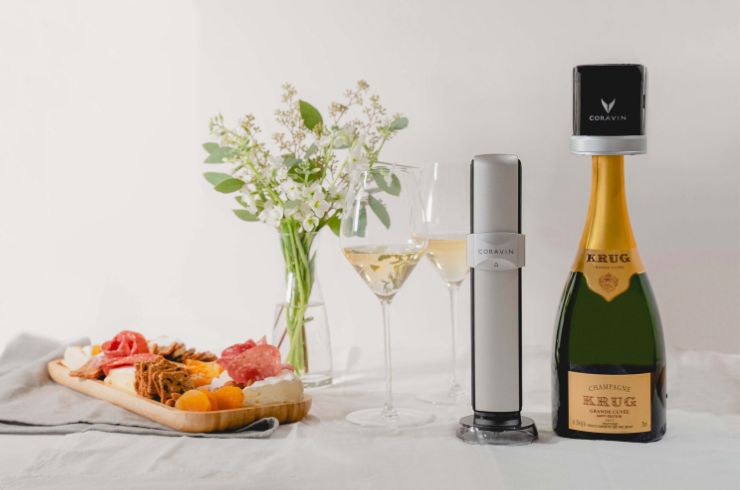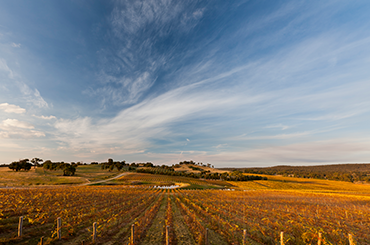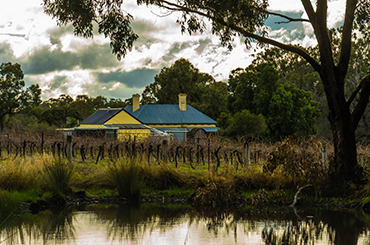Iron oxide helps give cosmetics their colour. It also gives Heathcote a big advantage when it comes to growing some of the most intensely coloured and flavoured shiraz on the planet. Taking the shape of lumpy little nodules the colour of rust, iron oxide is encrusted in the Victorian region’s red soil – a striking and highly visible feature throughout the area.
A host of metals stick to iron oxide – copper and tin included – breaking up the soil and proving a handy conduit for vine roots to go long and deep into the ground. It’s intense in colour, something the local sheep can appreciate when their fleece turns as red as a Manchester United jersey. Wine drinkers can appreciate it too when they set their eyes on the colour of Heathcote red wines: iridescent to the Nth degree.
Coonawarra has its terra rossa, but Heathcote has its iron-oxide-laden soils derived from rock of the Cambrian age – the oldest in Victoria at 500 million-plus years. Like terra rossa, the Cambrian soil runs in a loose strip, at its widest only a couple of hundred metres. It starts eight kilometres south of the township of Heathcote and runs 35 kilometres north. It’s deep, well drained and produces wines high in natural acidity, verve and that extraordinary hue; Hanging Rock winemaker Rob Ellis calls it “extreme”.
When it meets the shiraz grape, the planets align; the chemical compounds create energy in the glass. But not every producer has vineyards on Cambrian soil. It’s one of the great, unseen divisions in the wine region. The other is size. The Heathcote wine region is so vast, winemakers speak of a north, south and a centre. Covering 1910sq km, it is effectively three regions in one. There can be more than a month’s ripening difference between its warmer and cooler sites, and sometimes more, depending on the year.
Simon Osicka at Paul Osicka Wines on the eastern border reports that in just a two-year period – 2016 to 2017 – he saw almost two months’ difference in harvest dates for the same grapes. The region, like many, has been experiencing some climatic extremes, but Simon remains enthusiastic about the future. “When I taste and understand what other people are up to in the region, I see us about to head into a pretty exciting time,” he says. “Shiraz here is in a better place than 10 or 20 years ago.”
To the south, the landscape rocks and rolls with granite outcrops interrupting green pastures. It’s excellent country for fine-edged rieslings and taut chardonnays, sharing not only a boundary, but also a similar vinous personality with the Macedon Ranges. At Tooborac, Merindoc Vintners, owned by the Shelmerdine family, explores Rhone Valley grape varieties, including a pretty, textural viognier. But it is riesling – a wine of purity and deep minerality – that may best account for the style of the subregion.
Immediately north of the Heathcote township is where the region was born as a wine-growing area, crossing the wine-drinker’s radar with a flurry of activity over an intense seven-year period. This time saw the creation of Zuber Estate (1972), She-Oak Hill Vineyard (1975), Mount Ida (1976), Heathcote Winery and Romany Rye (1978), and Jasper Hill (1979).
Shiraz loved the dirt from the start, but the plantings came at a time when cabernet sauvignon ruled. Winemakers such as Ron Laughton of Jasper Hill remember a tense few years getting the shiraz grape taken seriously. His commitment to the variety, as well as to biodynamic winegrowing and “keeping it simple” in the winery, has seen him inspire many to follow in the region. This includes Rhone Valley maker Michel Chapoutier, who now works with Ron on the joint La Pleiade shiraz project.
Tony Hunter of Sanguine Estate was another producer who found inspiration in Ron Laughton’s wines. “What made me fall in love with Heathcote was drinking old Jasper Hills,” Tony says. His family winery’s three shiraz wines are well known for their generous flavour and texture, but winemaker Mark Hunter also wants to explore other possibilities, such as Spanish-style reds tempranillo and grenache.
“We were visited by noted viticulturist Richard Smart, who encouraged us to look into tempranillo because Heathcote came in similar to Rioja in heat-degree days,” Tony says, referring to the measurement used to indicate the accumulation of heat during a growing season.
Sanguine Estate Tempranillo, although made in small quantities, shows excellent potential, with lively and intense red liquorice and spice, a generous mouthfeel and dry finish that Spanish drinkers would applaud.
It makes a fine book-end with tempranillo from Tar & Roses, which sources fruit from Kennedy Vintners at Colbinabbin in northern Heathcote. Simon Osicka has also planted grenache and mataro (AKA mourvedre and monastrell). In a potentially warmer, drier future, maybe Spanish grapes are the start of something big.
The Heathcote-Rochester Road has been the scene of intense vineyard plantings in recent years. The road follows the Mount Camel Range heading north – a high ridge that moves into some of the warmer vineyard sites in the region, and some of the biggest too. Here, another division opens up: between those who irrigate and those who don’t, and the effect that can have on yields and price.
Hanging Rock Winery, based in the Macedon Ranges with a vineyard in Heathcote, celebrated 30 years of Heathcote shiraz in 2017, and founder John Ellis remembers early issues sourcing water for vines from a bore that became too salty. “We capped it and haven’t used it since,” he says.
They then had to adapt to a new way of doing things in the vineyard. “In a dry-land vineyard like ours [in Heathcote], you have to drop fruit in order to get it ripe.” Yields react accordingly; they fall. The Ellis family regularly gets less than one tonne of fruit to an acre of grapes. Some competitors, who have brought Heathcote shiraz into the realm of the everyday at reasonable prices, can achieve around four tonnes to the acre. “[That yield] is great, cheap, reliable viticulture, but we want to make great wine,” John says. His 2013 Hanging Rock Shiraz sells for $75.
It’s hard to imagine Heathcote without shiraz. Part of its appeal is its many faces: Jasper Hill’s savoury spice; Tellurian Wines’ textural warmth; Vinea Marson’s super food-friendly blend with a splash of viognier; Heathcote Estate’s structure; Paul Osicka Wines’ earthiness; and Syrahmi’s absolute prettiness.
But inching its way into the bigger picture is a group of red and white grape varieties, and their growing impact can’t be ignored. “We planted sangiovese 18 years ago, about the same time as one other vineyard in Heathcote,” says Greg Flynn of Flynn’s Wines. “There weren’t any Italian varietals planted in the area, so we planted and hoped. It turned out to be one of our best decisions.” Greg lauds the grape’s natural balance. “Better than shiraz, mostly,” he says.
His neighbour Adrian Munari at Munari Wines agrees, believing vermentino to be the standout white in the region. “It seems to like the hotter conditions without succumbing to acid reduction and overblown fruit characters,” Adrian says. Fiano looks good too, although plantings remain small.
Mario Marson has recently branched into some lesser-known Italian grape territory, grafting three rows of shiraz vines over to refosco dal peduncolo, mondeuse (it’s French, yes, but also grows in Sicily) and barbera. These are in addition to the sangiovese and nebbiolo already in the ground. “Nebbiolo is very delicate and doesn’t like stress, but in years like 2015 and 2017, you can make great wine,” Mario says.
Brown Brothers has vineyards in the north with dolcetto, montepulciano and nero d’avola planted, but the family that has staked the biggest claim is Chalmers with its vineyard at Colbinabbin planted to 24 varieties, many Italian, released under their Montevecchio wine range.
Shiraz had better watch out. Italians are on the rise.
This article originally appeared in issue #38 of Halliday magazine as ‘Some like it hot’. Become a member and never miss an issue.





